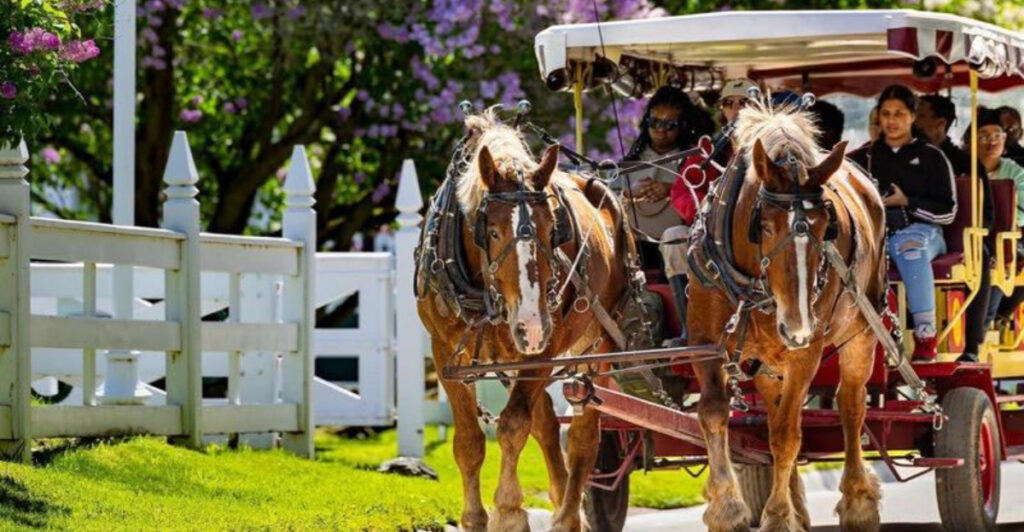Nestled in the waters between Michigan’s upper and lower peninsulas sits a place frozen in time. Mackinac Island banned automobiles in 1898, creating America’s only truly car-free community. Here, the clip-clop of horse hooves replaces engine rumbles, and the pace of life slows to match the rhythms of nature rather than the rush of modern traffic.
A Historic Ban That Shaped an Identity
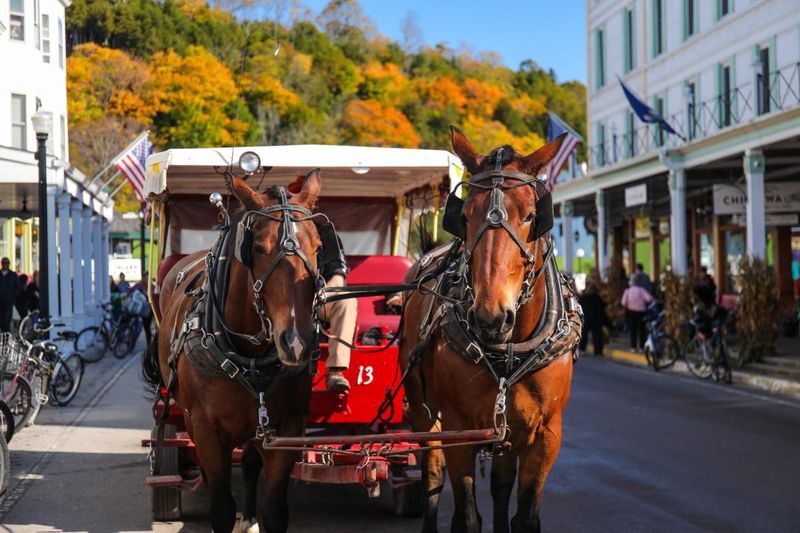
When a car backfired and spooked the island’s horses in 1898, local leaders took swift action. They passed an ordinance banning motorized vehicles—a decision that would define Mackinac’s character for generations to come.
The Mackinac Island State Park Commission expanded this prohibition island-wide in 1901. What began as a practical safety measure evolved into a treasured tradition that residents proudly maintain to this day.
Over 125 years later, the absence of cars isn’t viewed as an inconvenience but as the island’s greatest asset. As one park director noted, this commitment to horse-powered transportation remains “truly at the top of why it is such a special place.”
The Working Horses of Mackinac
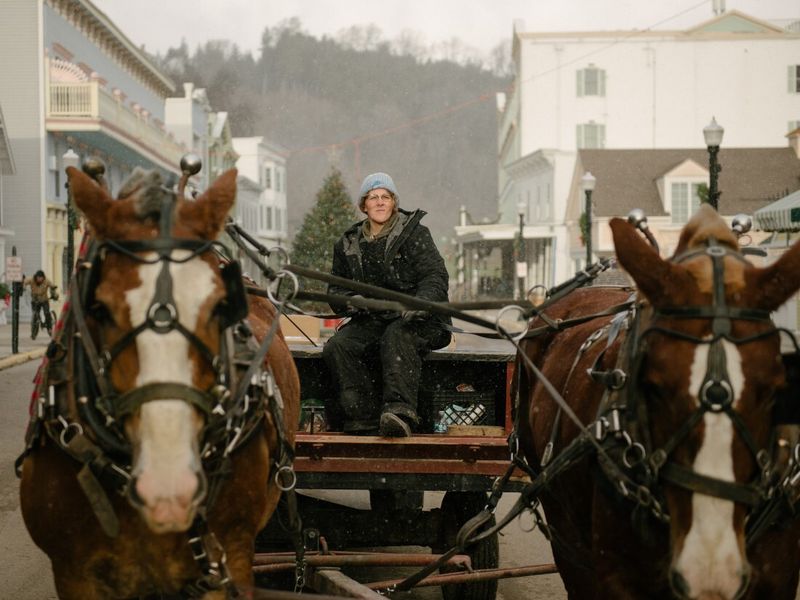
Nearly 600 horses power daily life on Mackinac Island, forming the backbone of the local transportation system. These hardworking animals pull everything from tourist carriages to delivery drays loaded with mail, groceries, and building materials.
Each spring, the horses arrive by ferry from mainland farms where they winter. Throughout the tourist season, they work in shifts, receiving regular rest periods and veterinary care.
The island’s equine workforce includes draft breeds like Percherons and Belgians for heavy hauling, while smaller horses handle taxi services. Far from being mere attractions, these animals perform essential roles in maintaining the community’s car-free lifestyle.
M-185: America’s Only Car-Free Highway
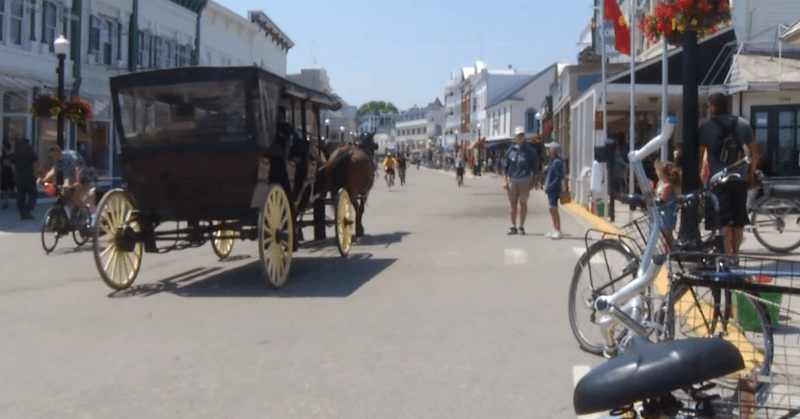
Circling Mackinac Island’s perimeter, M-185 holds a unique distinction as the only state highway in America where motor vehicles are prohibited. This 8.2-mile paved road hugs the shoreline, offering spectacular views of Lake Huron, the Mackinac Bridge, and neighboring islands.
Bicyclists, joggers, inline skaters, and horse-drawn carriages share this scenic route. Without worrying about automobile traffic, visitors can pause anywhere to snap photos or watch freighters passing through the Straits of Mackinac.
During winter, when ferry service becomes limited, the highway transforms into a snowmobile route—the sole exception to the island’s motorized vehicle ban.
Bicycle Culture: Freedom on Two Wheels

Bicycles reign as the preferred mode of personal transportation on Mackinac Island. Visitors can bring their own or choose from thousands of rental bikes available in various styles—from tandem and mountain bikes to cruisers with baskets perfect for picnic supplies.
Island residents rely on bicycles year-round, outfitting them with studded tires for winter travel. You’ll spot locals pedaling with grocery bags dangling from handlebars or children bundled in bike trailers.
The absence of cars creates a cyclist’s paradise where riders of all ages and skill levels share the road safely. Many visitors report rediscovering the simple joy of cycling while exploring the island’s varied terrain, from flat shoreline paths to challenging inland hills.
Victorian Architecture Frozen in Time
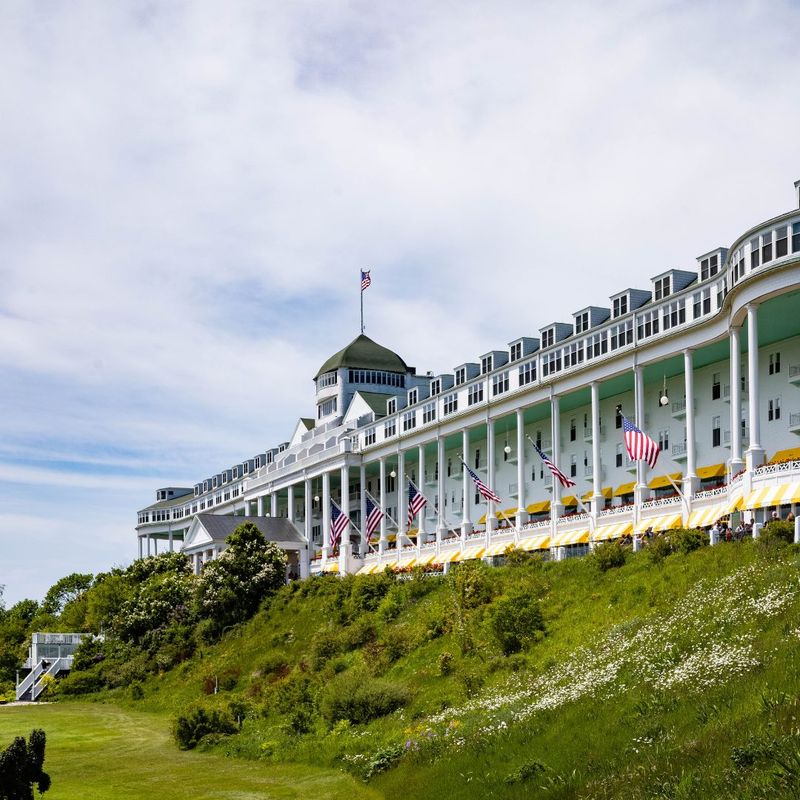
The Grand Hotel stands as Mackinac’s crown jewel, boasting the world’s longest front porch at 660 feet. Built in 1887, this white-columned masterpiece remains virtually unchanged, offering guests the same views enjoyed by visitors in the Victorian era.
Beyond the Grand, the island showcases numerous preserved 19th-century homes with intricate gingerbread trim, wraparound porches, and vibrant colors. Many of these architectural treasures now serve as bed-and-breakfasts or summer residences.
The absence of cars and modern infrastructure has protected these historic structures from alterations that might otherwise have accommodated automobile culture. Walking through downtown feels like stepping into a living museum where buildings tell stories of a bygone American era.
Fudge: The Sweet Taste of Tradition
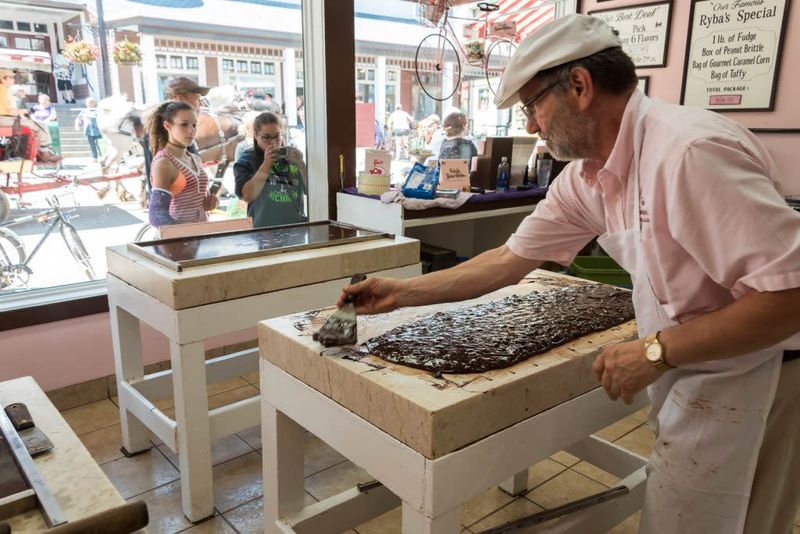
The aroma of chocolate wafts through downtown as confectioners fold creamy mixtures on marble slabs in storefront windows. Mackinac Island fudge has achieved legendary status, with some shops using recipes dating back to the 1880s.
Visitors watch mesmerized as skilled fudge makers pour, cool, and shape the sweet treats into loaves before slicing them for purchase. The island produces over 10,000 pounds of fudge daily during peak season, earning tourists the nickname “fudgies.”
The car-free environment enhances the sensory experience—without exhaust fumes, the sweet scents travel uninterrupted through the air. Many shops offer horse-drawn delivery to hotels, maintaining the island’s commitment to traditional transportation even for its famous confection.
Natural Wonders and Hidden Gems
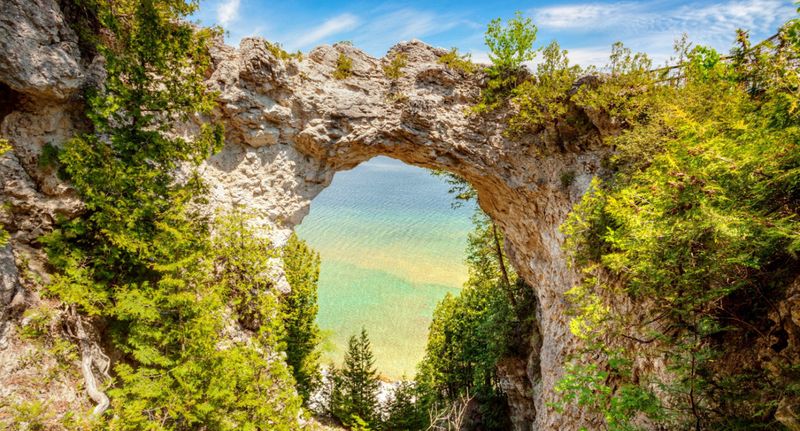
Arch Rock soars 146 feet above the lake, forming a natural limestone bridge that frames perfect views of Lake Huron’s blue waters. This geological marvel represents just one of many natural attractions preserved within the island’s 1,800-acre state park.
Sugar Loaf, a 75-foot limestone stack, rises mysteriously from the forest floor. Nearby, Skull Cave—a small limestone cavern—once sheltered fur trader Alexander Henry during Pontiac’s War in the 1760s.
The car-free environment has protected these formations from the erosion and development pressures common at other tourist destinations. Visitors access these sites via hiking trails, horseback, or carriage tours, experiencing them much as travelers did a century ago.
Indigenous Heritage and Cultural Roots

Long before European settlers arrived, indigenous Anishinaabe peoples called this island “Michilimackinac”—the Great Turtle—referencing its shape when viewed from a distance. Their spiritual connection to the land remains an important part of the island’s cultural tapestry.
The Native American Museum at the Biddle House preserves artifacts and stories from the Odawa and Ojibwe tribes who first inhabited the region. Traditional crafts, foods, and ceremonies continue to be celebrated during special events throughout the year.
The island’s car-free status aligns with indigenous perspectives on living harmoniously with nature. Many Native guides point out that the absence of motorized vehicles allows visitors to experience the island’s natural rhythms in ways similar to their ancestors.
Seasonal Celebrations and Timeless Traditions
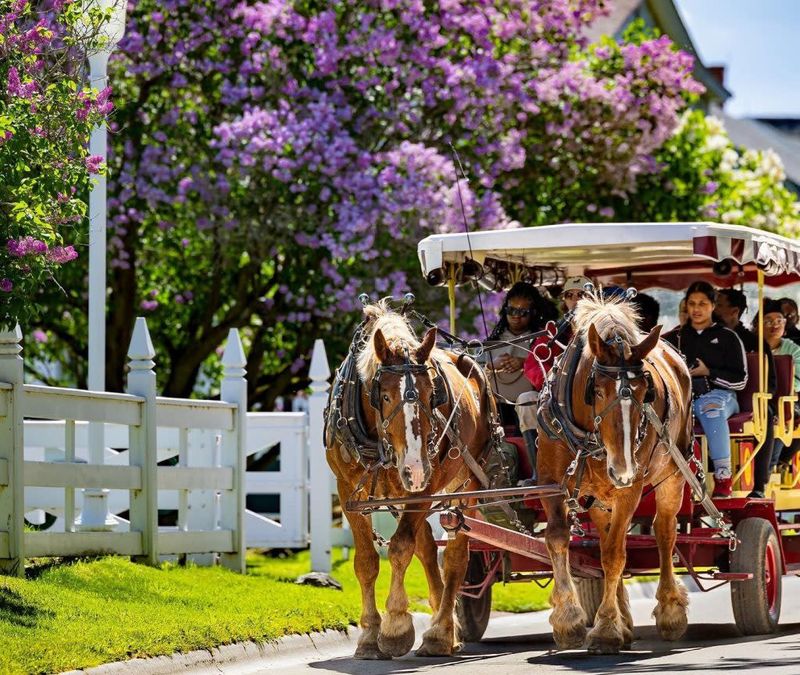
The Lilac Festival transforms the island each June with fragrant purple blooms and the nation’s only horse-drawn parade. This 10-day celebration showcases over 100 varieties of lilacs, some dating back to the Victorian era.
Throughout summer, weekly events like the Fort Mackinac Tea Garden concerts maintain traditions established generations ago. Fall brings spectacular color tours by carriage through maple-lined roads, while winter ushers in a quieter pace as the island population drops from thousands to hundreds.
Year-round residents celebrate Christmas with a community tree lighting and Santa arriving by horse-drawn sleigh instead of reindeer. These seasonal rhythms continue unchanged by modern transportation trends, preserving celebrations that would be familiar to islanders from a century past.
Living Car-Free: A Model for Sustainable Communities
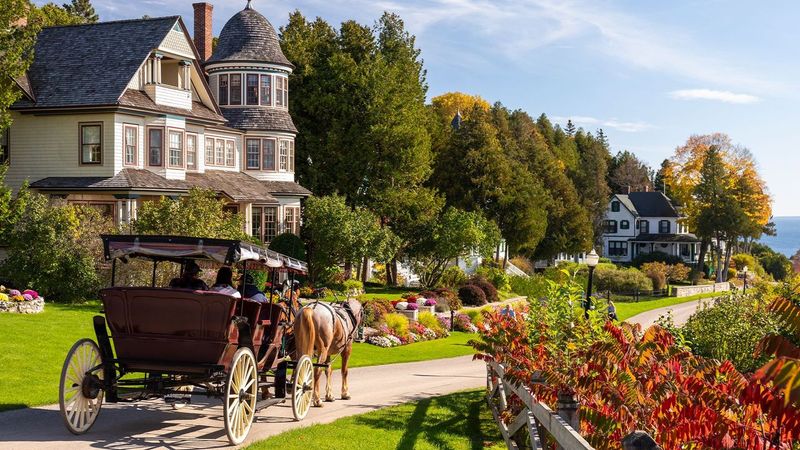
Urban planners worldwide study Mackinac Island as a rare example of a functioning car-free community in America. The island demonstrates how alternative transportation can support tourism, commerce, and daily life without sacrificing convenience or economic vitality.
Residents adapt creatively to car-free living—groceries arrive by horse dray, children walk to school regardless of weather, and emergency services utilize specialized horse-drawn ambulances and fire equipment. During winter, snowmobiles provide essential transportation when ice conditions prevent ferry service.
As cities increasingly seek to reduce carbon emissions and create more pedestrian-friendly environments, Mackinac offers valuable lessons. This island community proves that eliminating cars doesn’t mean sacrificing quality of life—in fact, many residents insist it enhances their connection to both place and community.

